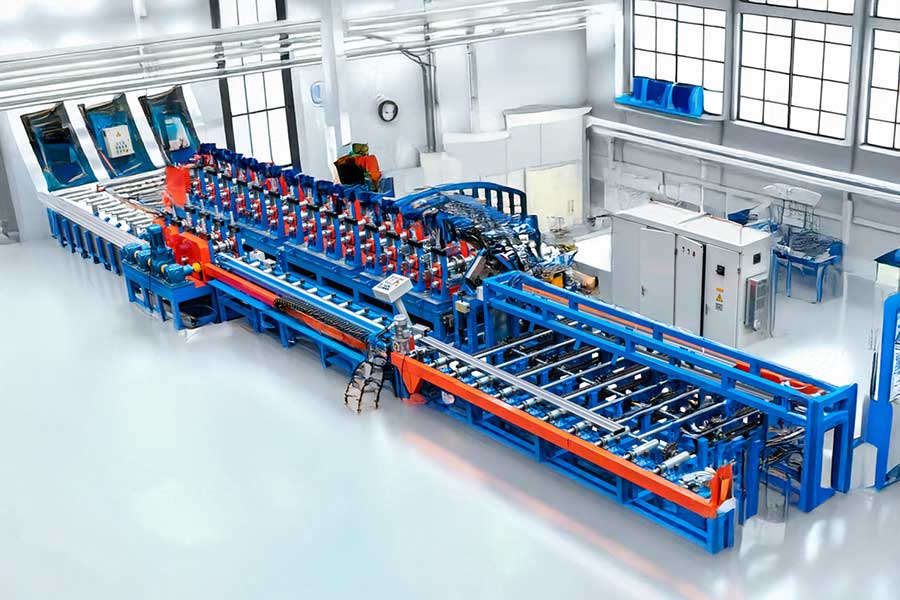
Digital twin technology, one of the innovations brought by Industry 4.0, stands out with its potential to make production processes smarter, more efficient and predictable. Especially in roll forming machines, which have complex and precise production processes, digital twin applications offer groundbreaking benefits. So, what exactly is digital twin technology in roll forming machines and what advantages does it provide to businesses?
What is a Digital Twin? Definition in the Context of Roll Forming Machines:
A digital twin is a virtual representation of a physical asset (in this case, a roll forming machine or an entire production line), process, or product. This virtual copy is constantly updated with real-time data and is in a dynamic connection with its physical counterpart. In the case of roll forming machines, the digital twin can use data collected from the machine's sensors, control systems, and other sources to simulate the machine's current state, performance, and even possible future behavior.
Benefits of Digital Twin Technology in Roll Forming Machines:
- Real-Time Monitoring and Performance Analysis: The digital twin provides the opportunity to analyze the performance of the roll forming machine in detail by instantly monitoring the operating parameters (speed, pressure, temperature, etc.). In this way, possible problems can be detected early.
- Predictive Maintenance: By analyzing the data received from the sensors on the machine, potential failures can be predicted in advance and production stoppages are prevented with planned maintenance works.
- Process Optimization and Improvement: Digital twins offer the opportunity to test different production scenarios in a virtual environment. In this way, the most efficient process parameters can be determined and production speed, material flow and energy consumption can be optimized.
- Virtual Commissioning and Testing: It becomes possible to commission and test new roll form lines or designs in a virtual environment. This ensures that possible errors are eliminated before the actual installation and the commissioning time is shortened.
- Advanced Operator Training: Digital twins provide virtual environments where operators can train on real machinery without risk and without disrupting the production process. This improves operator skills and reduces problems caused by misuse.
- Increased Product Quality and Reduced Defects: Process optimization and predictive maintenance ensure a more stable and controlled production process, which improves product quality and reduces the amount of defective products.
Digital Twin Application Areas in Roll Forming Machines:
- Machine Health Monitoring and Failure Prediction: Prediction of bearing failures, motor problems, or other mechanical problems by analyzing sensor data such as vibration, temperature, current, etc.
- Virtual Optimization of Process Parameters: Simulation of the effects of parameters such as different speeds, material feed rates, and platen settings on product quality and production efficiency.
- Virtual Testing of New Roller Designs: Prevention of potential problems (buckling, tearing, etc.) by testing new profile designs and roller configurations in a virtual environment.
- Operator Training Simulations: Training operators on machine usage, troubleshooting and maintenance procedures through realistic virtual environments.
- Historical Data Analysis and Trend Detection: Determining trends in production and predicting future performance by analyzing machine and process data.
Key Components of Digital Twin:
The digital twin of a roll forming machine usually includes the following components:
- Sensor Data: Real-time data collected from various sensors (temperature, pressure, vibration, position, etc.) on the machine.
- Simulation Models: Mathematical and physical models that mimic the physical behavior of the machine and the process.
- Historical Data: Historical performance records of the machine, maintenance logs and production data.
- Connectivity and Integration: The digital twin has a continuous and reliable data connection with the physical machine.
Result:
The use of digital twin technology in roll forming machines offers significant potential for transformation in production processes. Thanks to benefits such as real-time monitoring, predictive maintenance, process optimization, and virtual commissioning, businesses can create a more efficient, quality, and reliable production environment. Digital twins will continue to play an important role in the future of the roll forming industry.
